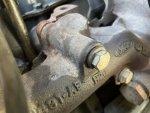- Joined
- Jul 11, 2020
- Messages
- 213
- Reaction score
- 43
- Points
- 28
- Age
- 42
- Location
- Los Angeles
- Vehicle Year
- 1988
- Make / Model
- Ford Ranger
- Engine Type
- 2.9 V6
- Transmission
- Automatic
- 2WD / 4WD
- 2WD
Hi guys!
The refinement process continues on my '88 XLT 2.9. Truck was left sitting for a week or 2 while i was replacing alternator and rewiring. WHen i started the project I found the top bolt at the exhaust header (#5 cylinder) looked damp. Pic attached.
About a year ago I replaced all of the injectors, which was a brutal learning process in finding and using the right injector. All was well afterwards though, and a misfire i was hoping to cure was indeed fixed. Now, a new gremlin, in the way of a periodically spiking tachometer and horrific mpg. This morning i did clear engine start routine and after a few turns, truck actually turned over. SO i believe this is a pretty clear smoking gun? It doesnt smell (like, really smell) like gas so my fear is that its coolant. O rings look fine there is not fuel on the plenum or on inhjectors themselves.
SO, question to the forum, would you also assume this is leaking injector? Would a damaged ground wire cause this to remain constantly open? Or is it more likely a mechanical failure with the injector? And finally, do y'all have any tricks to coax this thing shut while its still in the fuel rail? Or do i need to get back into the guts of this thing.
thanks
The refinement process continues on my '88 XLT 2.9. Truck was left sitting for a week or 2 while i was replacing alternator and rewiring. WHen i started the project I found the top bolt at the exhaust header (#5 cylinder) looked damp. Pic attached.
About a year ago I replaced all of the injectors, which was a brutal learning process in finding and using the right injector. All was well afterwards though, and a misfire i was hoping to cure was indeed fixed. Now, a new gremlin, in the way of a periodically spiking tachometer and horrific mpg. This morning i did clear engine start routine and after a few turns, truck actually turned over. SO i believe this is a pretty clear smoking gun? It doesnt smell (like, really smell) like gas so my fear is that its coolant. O rings look fine there is not fuel on the plenum or on inhjectors themselves.
SO, question to the forum, would you also assume this is leaking injector? Would a damaged ground wire cause this to remain constantly open? Or is it more likely a mechanical failure with the injector? And finally, do y'all have any tricks to coax this thing shut while its still in the fuel rail? Or do i need to get back into the guts of this thing.
thanks
Attachments
-
190.7 KB Views: 88















